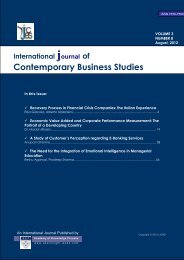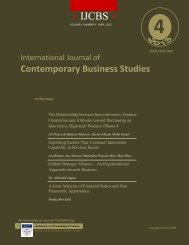Contemporary Business Studies - Academy of Knowledge Process ...
Contemporary Business Studies - Academy of Knowledge Process ...
Contemporary Business Studies - Academy of Knowledge Process ...
You also want an ePaper? Increase the reach of your titles
YUMPU automatically turns print PDFs into web optimized ePapers that Google loves.
International Journal <strong>of</strong> <strong>Contemporary</strong> <strong>Business</strong> <strong>Studies</strong>Vol: 4, No: 2. February, 2013 ISSN 2156-7506Available online at http://www.akpinsight.webs.com6(a) If the national culture <strong>of</strong> a parent company and subsidiary company is same in performanceorientation that will enhance the performance <strong>of</strong> the firm going for international diversification.6(b) If the national culture <strong>of</strong> a parent company and subsidiary company is different in performanceorientation that will negatively affect the performance <strong>of</strong> the firm going for internationaldiversification.Luo and Peng (1999) argue that differences in national culture tend to lower performance when MNEsenter new markets. Cultural clash can happen in case <strong>of</strong> different national cultural <strong>of</strong> parent andsubsidiary company (Brock, Barry, & Thomas, 2000). Very, Lubatkin, and Calori (1996) observed theinfluence <strong>of</strong> national culture in merger and post acquisition performance <strong>of</strong> cross national firms. Wedidn’t succeed to find a very good support for human orientation because it’s a new dimension identifiedin GLOBE study and not much work has been done on this dimension <strong>of</strong> culture. We now propose thefollowing proposition regarding human orientation dimension on the basis <strong>of</strong> our hypothetical frame workused in this study.PROPOSITION:7National culture dimension <strong>of</strong> human orientation moderates the relationship between internationaldiversification strategy and performance.7(a) If the national culture <strong>of</strong> parent company matches the human orientation <strong>of</strong> subsidiary companythat will enhance the performance in case <strong>of</strong> international diversification.7(b)If there is a difference in human orientation <strong>of</strong> parent and subsidiary organization ,theperformance will be affected negatively in case <strong>of</strong> international diversification.DISCUSSIONFrom the above review and proposition we came on the main point that firms should first identify theirdiversification zone as per culture <strong>of</strong> its own country and than go to the relevant zone countries fordiversification. That will lead towards cultural support in post integration period and hence will improvethe chances for successful integration that is mandatory for excellent firm performance. Countries thatmismatch in national culture dimension can face problems in post diversification integration and that willnegatively affect firm performance.The strategy literature showed a little support <strong>of</strong> this notion as Harrison, McKinnon, Panchapakesan, andLeung (1995) suggest that nations with same l cultural background should collected together and shouldbe compared with other groups not having similar cultural background. In view <strong>of</strong> h<strong>of</strong>sted national culturedimensions, New Zealand (NZ) and Australia are in same group by score. And examples <strong>of</strong> mismatch arelike a parent company is from Japan with low individualism and subsidiary is from Australia with highindividualism. Organizations from different cultural settings may face resource sharing problem whileinvolved in diversification or merger acquisition. We have divided the h<strong>of</strong>sted’s score into threecategories and identified three different diversification zones. Firm should first identify that in which zoneit is grouped as per h<strong>of</strong>sted’s score and than top management must look to diversify the firm in a samezone .The cultural fit between the two companies while operating in same national culture will supportpost diversification integration and would be the cause for enhanced performance in case <strong>of</strong> internationaldiversification. In case <strong>of</strong> our propositions the firms operating in different diversification zone will notperform better due to problems encounter <strong>of</strong> cultural clash and problems in post diversificationintegration. We divided h<strong>of</strong>sted score into three ranges lower range, medium range and higher range andidentified three diversification zones.2013©<strong>Academy</strong> <strong>of</strong> <strong>Knowledge</strong> <strong>Process</strong>95
















